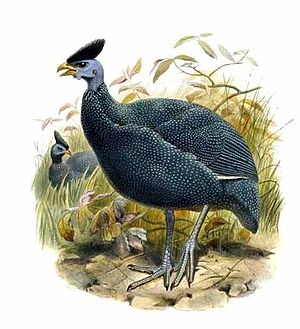Plain-hooded guinea fowl
| Plain-hooded guinea fowl | ||||||||||
|---|---|---|---|---|---|---|---|---|---|---|

Plain-crested guinea fowl ( Guttera plumifera ) |
||||||||||
| Systematics | ||||||||||
|
||||||||||
| Scientific name | ||||||||||
| Guttera plumifera | ||||||||||
| ( Cassin , 1857) |
The plumed guineafowl ( Guttera plumifera ) is a bird art from the family of guinea fowl . The shy, medium-sized guinea fowl lives in the rainforests of western equatorial Africa.
description
With a length of 45–50 cm, the plain-hooded guinea fowl is one of the medium-sized guinea fowl species and is roughly the size of a pheasant . The weight is between 750 and 1000 g. A sexual dimorphism is not pronounced, but males are slightly larger. The iris is brown. The legs and feet are bluish gray, of medium length and do not have a spur. The beak is bluish gray.
Adult birds wear a characteristic hood made of stiff, black, up to 3 cm long feathers on the vertex - a characteristic species feature that makes the species at best confused with the closely related curled-hooded guinea fowl . The rest of the head is featherless except for the neck and is gray-blue in the nominate form . Two relatively long flaps of skin hang down from the base of the beak. The body plumage is black and relatively densely covered with fine, white dots. These are largest on the lower neck. The short, inconspicuous tail is also spotted white. The wings are dark brown, the arm wings a little darker and have inconspicuous, white spots. The outer three arm wings show white outer flags that form a stripe on the closed wing.
In the youth dress, the head and neck are still covered by black dunes. The hood springs are shorter. The top and wing feathers are gray with blackish banding. The breast plumage is black-gray and has fine white dots and bands.
Distribution and existence
The distribution of the plain-hooded guinea fowl extends southward in equatorial Africa from southern Cameroon through Equatorial Guinea and Gabon and along the Loango coast in the Republic of the Congo . It extends eastward in the forests of the Congo Basin through the extreme south of the Central African Republic , the north of the Republic of the Congo and the north of the Democratic Republic of the Congo . The area extends to the west of the Great African Rift Valley and south to the northern tip of Lake Tanganyika .
The species does not seem to be common anywhere within its range. The occurrences are partly scattered and are limited to the area of the remaining primary forests . The population is roughly estimated at 10,000–100,000 birds, and the IUCN sees the species as not endangered, primarily because of its large distribution area.
Geographic variation
Two subspecies are described, of which G. b. schubotzi is characterized by orange-yellow areas of skin in front of the ear and on the neck. There is a hybridization zone in the eastern part of the Republic of the Congo.
- G. p. plumifera ( Cassin , 1857) - Cameroon, Equatorial Guinea, Gabon, and Republic of the Congo to the west of the 16th east longitude
- G. b. schubotzi Reichenow , 1912 - eastern part of the Republic of the Congo and the Democratic Republic of the Congo
Way of life
The plain-hooded guinea fowl lives in dense and moist rainforests with little undergrowth. It occurs mainly in primary forests, but also in older succession stages of secondary forests . The shy species can be found looking for food in groups of 20 to 40 birds in the dense forest. Clearings and cultivated land are avoided if possible. The peak of activity is in the hours around sunrise when the troops scrape up large areas of the forest floor to find their food. This consists of seeds, fruits, leaves and a wide range of invertebrates . At dusk, the sleeping trees are visited, which are changed daily.
Little is known about the breeding biology. Presumably the species is monogamous and breeds once a year. The breeding season is probably in the wetter season. In the Democratic Republic of the Congo, breeding birds were recorded in March and September. Presumably the species also breeds in other months. The nest is a simple hollow in the litter. The clutch consists of probably 9-10 beige eggs, which can appear spotty due to the soil in the forest floor.
literature
- Steve Madge , Phil McGowan : Pheasants, Partridges & Grouse. Helm Identification Guides, Christopher Helm, London 2002, ISBN 0-7136-3966-0 .
Web links
- Guttera plumifera in the endangered Red List species the IUCN 2008. Posted by: BirdLife International, 2009. Accessed October 29, 2011th
- Videos, photos and sound recordings of Guttera plumifera in the Internet Bird Collection